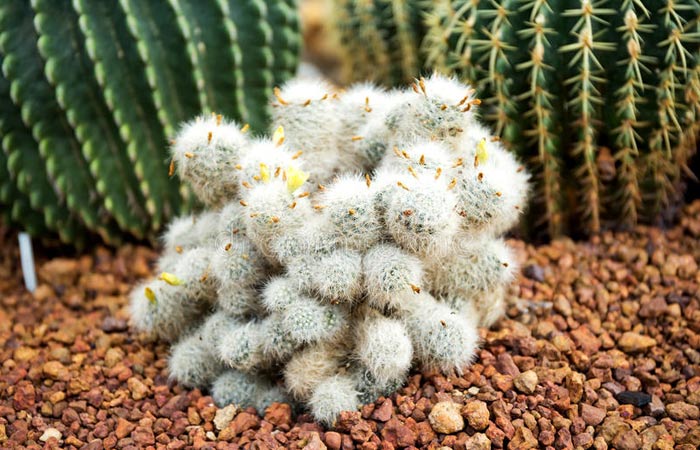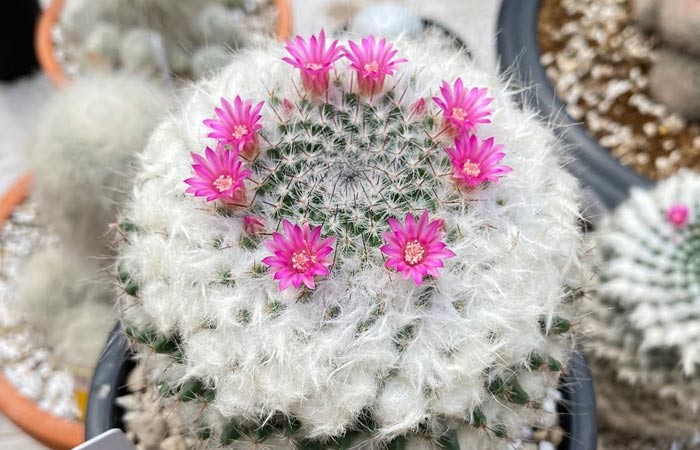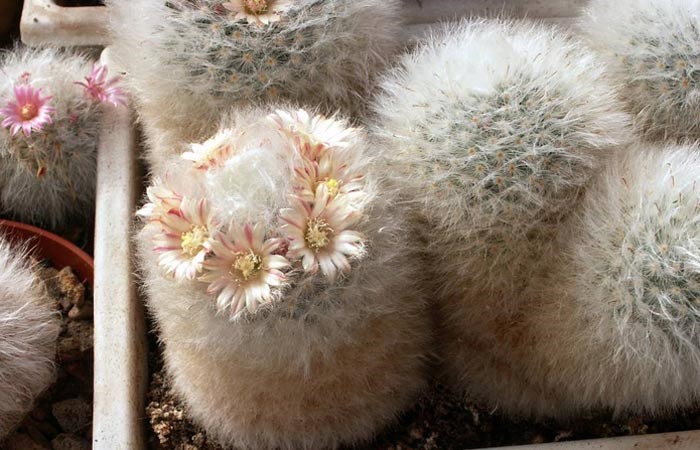15 Types of Hairy Cactus + Care Tips

The hairy cactus is widely known for its long hairs. These striking hair are modified spines, making this furry cactus look kind of snow-white. In different types of hairy cactus, the hair protects the cacti from frost and sunlight. As well as keeping the heat from the day to prevent the plant from freezing. So when you see a furry cactus, you’ll know that is it originally from somewhere with extreme weather conditions.
However, this white coat of hair is not the only spine that hairy cactus types have. In fact, the hair conceals sharp yellow central spines. Below, we’re going to talk about hairy cactus species, what their different types look like, and important tips on hairy cactus care and maintenance.
Types of Hairy cactus (Identification Guide)
If you are a cacti and succulent aficionado, or you’re simply looking to add a unique plant to your collection, the furry cactus is certainly a great choice. Now, let’s get familiar with types of hairy cactus:
Old Man Cactus (Cephalocereus Senilis)
The Old Man Cactus is famous for its long white hairs of Cephalocereus Senilis. This hairy cactus species from Mexico produces column stems in clusters with no braches, which can grow up to 16 to 50 feet in length. In a young Old Man Cactus, the hair is silvery white; growing as long as 8 inches. However, as this hairy cactus plant matures, it loses some of its hair coat, and the remaining hair can’t protect the plant the same as before.
Old man cactus flower produces early in the spring from the head of the plant, blooms at night, and is pink in color. If you’re planning to keep this plant indoors, you’ll rarely see the old man cactus flower. Remember that in an ideal situation, you’ll have to wait about 7 years to be graced by the old man cactus flower.
As mentioned in the beginning, Cephalocereus Senilis has sharp yellow spines beneath the white coat. So touch it carefully to avoid injury, or don’t touch it at all.
Powder Puff Cactus (Mammillaria bocasana)
Known as “Powder Puff Cactus” and “Snowball Cactus”, this furry cactus is a clumping variety, often forming large mounds. Basically if a cactus looks like a cotton ball (that may or may not be decorated by rings of cream or pale pink blooms), you’re looking at a mammillaria bocasana.
Clusters of silky white hairs cover this small furry cactus beautifully, and surround a yellow-to-red hooked spine. Found in Northern central Mexico, among volcanic rock on canyon walls in clusters, the snowball cactus offers different varieties and forms in cultivation with its fast growth-rate.
Hairy Roger Cactus (Opuntia Engelmannii)
Also known as Prickly Pear Cactus, Hairy Roger cactus is one of the well-known types of hairy cactus. This plant is native to Mexico and displays soft, white cotton-like hair that erupts out of the areolas. Beginning at the base of the Hairy Roger Cactus, the hair can grow to multiple inches in length.
In place of spines, Hairy Roger cactus’ tiny glochids grow from the areolas for extra protection. As the Hairy Roger cactus matures, its hair often becomes thick enough to cover and hide its green body completely. This hairy cactus species offers edible fruits while tolerating drought and poor soil.

Peruvian Old Man Cactus (Espostoa Lanata)
Peruvian Old Man cactus is a columnar cactus from the genus Espostoa and the family Cactaceae. Hailing from Peru and Ecuador, the Peruvian Old Man cactus is also known as Cotton Ball Cactus, Snowball Old Man, Woolish Espostoa, and Snowball Cactus.
Native to Ecuador, Peru, and Bolivia deserts with 800 to 2,000 meters above the sea, this furry cactus can reach several meters in height, but slowly. Similar to other types, this one also gets its name from the long bristles that cover it and give it that woolly appearance.
This hairy cactus species is very similar to Cephalocereus Senilis or the old man cactus. In fact, the hairy cactus care and maintenance for both of these types are interchangeable. The main difference between them is that the Peruvian Old Man cactus has sharp spines or thorns and the old man cactus doesn’t.
Opuntia Hairy cactus (Opuntia Polyacantha var. erinacea)
Also known as Grizzly Bear Prickly pear, this succulent is also famous in hairy cactus types. Opuntia hairy cactus is also called Hedgehog Prickly pear, Grizzly Bear cactus, Prickly Pear, and Mojave Prickly pear. With bluish-green stems that form clumps at the base, the stems are covered by thick long, gray, and downward spines.
You can find this furry cactus Mojave Desert Scrub and Pinyon-Juniper Woodland, where it grows up to 4 to 12 inches high and about 36 inches wide on well-drained sandy, gravelly, and rocky soils abundantly. You may also see it while hiking middle elevations in the mountains around Las Vegas.
In the early spring, the Opuntia hairy cactus blooms (they are produced on the previous year’s growth). The hairy cactus flower on this plant is either bronze, yellow, or pink. When they mature, they produce spiny green fruits that you can eat.
Old Man of the Andes (Oreocereus Celsianus)
This is another columnar variety that grows up to 3 meters in its natural habitat (meaning Argentina, Bolivia, and Peru). Completely clothed with withe hair, it is hard to notice the ribbed shape of the furry cactus’s stems.
This dense cover also protects the plant from the intense ultraviolet. Thanks to the antifreeze chemicals in its sap, it’s frost resistant as well.
Monkey Tail Hairy cactus (Hildewintera Colademononis)
This magnificent succulent, like other types of hairy cactus, can make any dull space intriguing. Monkey tail hairy cactus has long stems that can outgrow any basket or pot. Obviously, these stems are also covered with thick hairs that are actually thin and long spikes.
This hairy cactus species is popular among growers and gardeners since they can use it to cover holes, drape whole rocks and parts of walls in gardens and any other green spaces. Monkey tail hairy cactus branches grow upwards when it’s young, and head downwards later. The stems in this hairy cactus species can reach 8 feet in length, making it perfect for large spaces too.
The stunning furry cactus flower on this succulent is about 3 inches long and grows straight on the monkey tails of the plant. The monkey tail hairy cactus flower has multiple layers of petals, with bright red (and sometimes orange or purplish-pink) color. They stay open for a few days in the summer and then produce fruits.
If you’re a beginner and an admirer of this cactus family, this furry cactus is great for start, as it is easy to propagate from cuttings or seeds.

Old Lady Cactus (Mammillaria Hahniana)
Among different types of hairy cactus, the Old Lay Cactus is also indigenous to Mexico. It has spherical stems that can get to about 5 inches wide. The size of the plant itself can grow up to about 10 inches tall and 20 inches wide. These can help you with hairy cactus identification.
The stems of this plant are covered in white spines, hence giving it the name of Old Lady cactus. The hairy cactus flower that this succulent produces in spring and summer is red-purple. Sometimes, the furry cactus flower can form an impressive ring around the tip of the stems. Compared to other types of hairy cactus, the Old Lady cactus is very convenient as well.
Polar Bear Cactus (Austrocylindropuntia Floccose)
Also called waraqu, wool cactus, and living snow, this interesting furry cactus produces colonies of up to 60 cm of diameter (or even larger) that are covered with dense white hair, yellow spines, and bright yellow blooms from time to time.
Native to central Peru, you can find this hairy cactus in the high Puna region in dry valleys and rocky slopes, looking like a lying sheep from a distance.
Peruvian Old Lady Cactus (Espostoa Melanostele)
Also known as the Cactus Strawflower, due to its resemblance to old lady, this hairy cactus gets its name from it, it is also easier to see when it’s blooming and fruiting. Similar to some types of hairy cactus, it is also native to Peru. This hairy cactus species produces flowers and edible berry-like fruits.
The Peruvian Old Lady hairy cactus flower is yellow. It opens in the morning and stays open until evening. In the evening, the hairy cactus flower closes and stay closed until the next morning. The hairy cactus flower also remains closed when it’s raining. Remember that if you grow this plant in a container, it won’t mature and flower.
This columnar plant can grow up to 7 feet from clumps at the base in the wild. But in containers, this hairy cactus species grow less than a foot in a decade. The Peruvian Old Lady cactus’ spines can reach 1.5 inches in length. They are present even when the hairy cactus plant is young. Although the spines detach easily, they cause some injury.
Park Hedgehog Cactus (Pediocactus Paradinei)
Also known as Park Pincushion-Cactus, Kaibab Plains Cactus, Bristly Plains Cactus, Paradine Cactus, Kaibab, and Houserock Valley Cactus, this globose plant is originally found in East side of the Kaibab Plateau and west edge of House Rock Valley in Northern Arizona in small and scattered patches.
Growing this hairy cactus from their own roots is really challenging, but on their own roots, they are in fact very hardy. They like to feel the wind, so don’t grow them in a humid and heated greenhouse.

Old Man Opuntia (Opuntia Vestita)
This slender columnar cactus from high altitude is one of the furriest in the bunch and occurs in Argentina and Bolivia. The “vestita” in the plant’s name refers to its vestments, the clothing of white hair that resembles patches of snow in high mountain peaks in its habitat.
Hairy Stemmed Rhipsalis (Rhipsalis Pilocarpa)
This attractive variety from Brazil showcases long hairy, cylindrical stems with white fragrant, blooms. This furry cactus forms pendent bushes, it is quite variable and super convenient to cultivate and care for.
Austrocylindropuntia Lagopus
It may not have an accepted and famous common name, this furry cactus is one of the cutest plants to add to your succulent collection. Compared to other types, this species grows near the ground and forms very dense and large cushions that reach several meters in diameter but less than a meter in height, covered in yellowish hair up to 2 centimeters long.
Sometimes the hair is so dense (especially in its natural habitat) that hides the leaves entirely, helping this furry cactus to be a winter-hardy species. If you’re interested in this type, keep in mind that their seeds are difficult to find and germinate. So we suggest propagating by cutting or grafting which is more promising.
Eulychnia Saint-Pieana
This showy and popular furry cactus is actually a morphological form of Eulychnia breviflora. Although famous for its hairy areoles, you can find them throughout the distribution range of the species, making it difficult to classify this plant as a separate hairy cactus variety.

Hairy Cactus Care
All hairy cactus types are great succulents whether you’re a beginner or not. They are striking plants that you just have to add to your house. Remember that apart from their vital needs, they need little extra care. For example, since they grow in a straight line, you don’t need to prune them. We know different types of hairy cactus, let’s see how you should keep them.
Also, you can read about: Cactus grafting
Water
Before watering types of hairy cactus, let the top few inches of the soil dry out. If you are struggling with rotting problems in hairy cactus types, you are over-watering your plant. Remember to reduce the watering in fall and winter.
Soil & Fertilization
Different types of hairy cactus require well-draining soil. The best soil in hairy cactus care is a pre-made cactus soil or a mixture of sand, perlite, and soil that is suitable for cacti. If you want, you can fertilize your plant with a low-nitrogen fertilizer during its active growth period. A slow-release applied in the spring is going to be sufficient for one year.
Pot & Repotting
If you are not sure about the pot for growing types of hairy cactus, we suggest natural terra cotta pots with drainage holes. This type of pot lets the water evaporate out the sides. And since hairy cactus types prefer their soil on the dry side, it is an ideal choice.
Although hairy cactus types grow slowly in a container, they might need a bigger pot in the future. Every few years, remove the plant’s root ball and check it. If you notice that the roots are wrapped around the bottom of the root ball, it is time to place your succulent in a new pot about 1/3 larger. It is a good idea to add new soil around the root ball to boost the growth of the roots.
To easily repot your furry cactus, read how to repot a cactus.
Light & Temperature
All hairy cactus types need lots of bright sunlight (between 4 to 6 hours). Various types of hairy cactus tolerate lots of sunlight. In fact, more is better. The more sunlight the cacti receive, the longer and thicker the hairs will grow. A working option is to treat these succulents as an indoor plant over the winter and place them on a South-facing deck during the summer.
Ideal temperatures for types of hairy cactus are 65 to 90 °F in the summer and 50 to 65 °F in the winter, when the plants tend to sleep.
Pests & Diseases
Types of hairy cactus are slightly prone to attracting pests. This is because insects like to hide in the hair on them. For this reason, be on the lookout for mealybugs, spider mites, and scale.

How to Reproduce Hairy cactus
You can easily reproduce types of hairy cactus from seeds. If you already have a hairy cactus species, you can collect fresh and high-quality seeds from your own plant. If not, you can purchase the seeds you want from reputable sources.
Then, all you need to do is sow the seeds in soil that drains well. You can sow them outdoors in zones 9 and 10 for plants. You can also do it indoors under a grow light or on a heated seed mat.
You can also propagate different types of hairy cactus by cutting a small branch from them and rooting it. However, this method inevitably leaves an unpleasant scar near the main stem’s base. If you want to remove an offset to use in reproduction, let it dry for a week so the wound heal. Rooting usually occurs in 3 to 8 weeks. Therefore, it is best to reproduce any hairy cactus species from seed.
Final Thought on the Furry Cactus
A furry cactus is not drastically different from other cacti. They are similar to others, with their famous spikes, but a layer of beautiful white hair covers them. A layer of hair that allows them to tolerate extreme sunlight and freezing temperatures better.
- In this post:
- Types of Hairy cactus (Identification Guide)
- Hairy Cactus Care
- How to Reproduce Hairy cactus
- Final Thought on the Furry Cactus



